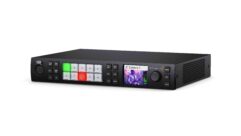
Picture This: Opportunity Knocks
Sep 1, 2008 12:00 PM,
By Jeff Sauer
Strong flatpanel sales and the approaching FCC mandate could help expand your business.

Research firm DisplaySearch reports strong shipments of Vizio’s 32in. VP322 HD plasma (pictured above), which is the smallest plasma available on the market. The unit’s strong numbers have most likely contributed to the large growth in flatpanel sales from Q1 to Q2 2008.
If you follow AV industry news regularly, you might have already read about the surprisingly strong TV sales over the last few months, despite the poor economic environment the country is in right now. Amid $4-per-gallon gasoline, the mortgage crisis, rising food prices, and failing banks, it’s no secret that consumers are generally being very cautious these days about discretionary purchases. Yet TVs — particularly flatpanels — are selling remarkably well in spite of economic forecasts.
Washington D.C.-based market-research firm MarketWatch reported that leading United States economic indicators fell 0.7 percent in July 2008. This points to a “slow growth for the rest of the year, and possibly an economy grinding to a halt,” according to MarketWatch’s conference board. Nonetheless, the TV market is doing anything but grinding to a halt.
DisplaySearch, a Texas-based research firm that tracks display sales, reported a whopping 26-percent increase in North American TV sales from Q1 to Q2 this year and a similarly eye-opening 28-percent increase in Q2 2008 sales compared to Q2 2007. This, according to DisplaySearch, represents the strongest growth in TV sales since the firm began tracking the data in 2004. What’s more, both LCD and plasma flatpanels experienced even greater gains from Q1 to Q2. LCD sales grew 30 percent Q/Q, and plasma units went up by 35 percent.
DisplaySearch notes that “strong initial shipments of Vizio’s 32in. HD [plasma display panel],” — now the smallest plasma available — are a large contributing factor to those plasma statistics. Furthermore, much of LCD’s sales growth also comes from panel shipments of smaller 19in., 22in., and 32in. form factors, because price points for those sizes are low. Still, LCD shipments in total were up 52 percent in Q2 2008 compared to Q2 2007, and plasma shipments grew 34 percent over the same period. Those are impressive numbers by any measure.
Lower prices explain a lot about the strong sales numbers, but they surely don’t say it all. Is this a case of consumers pampering themselves in tough times, rationalizing buying a new TV so they can save by not going out to the movies? Are these strong sales numbers the result of bargain hunters finding deals at desperate electronics sellers? Perhaps it’s both of those things.
But there’s something else out on the horizon that probably helps explicate these purchases too, and it’s an opportunity that installers shouldn’t pass up — especially amid the current tough economic times.
Picture This: Opportunity Knocks
Sep 1, 2008 12:00 PM,
By Jeff Sauer
Strong flatpanel sales and the approaching FCC mandate could help expand your business.
FEBRUARY 2009
As hopefully everyone in our industry knows (although, regrettably, that’s probably not the case), the FCC has mandated that in February 2009 all television stations across the country will stop transmitting analog television signals over the air and transition to an all-digital nationwide television broadcast system. It’s supposed to be a win-win all around.
For the consumers, digital images don’t degrade as much as analog signals, so there’s the potential for an immediate increase in image quality. (Although, it’s important to remember that DTV is not the same as HDTV; that is, all HDTV will be digital, but digital channels not specifically listed as HD will still be delivered in standard-definition resolution and not at even higher HD quality.) For the stations, it means more bandwidth and an opportunity to increase revenue. One standard-definition digital channel requires only about one quarter of the bandwidth of one current analog station. This means that local stations can send out four revenue-generating channels in the space of one old one. HDTV is better quality than standard-definition digital. Although it requires more bandwidth, it is only about the same amount as one analog channel. After next February, the FCC will sell off the then-unused frequency spectrum to other communications industries, bringing money to the federal government.
That’s the background, but what consumers are undoubtedly hearing and focusing on is that there’s a chance their current television sets aren’t going to work after February next year. Whether that’s the direct cause of the surge in new TV sales reported by DisplaySearch or simply a contributing rationale for upgrading, self-pampering, or just keeping up with the Joneses, it’s clearly got consumers thinking, if not exploring their home-entertainment options.
Naturally, there’s a lot of misinformation in the marketplace about this impending transition to DTV. First, it really should only affect those who receive television signals over the airwaves through an antenna rather than over cable and satellite. Those households will need a television (or televisions) that includes a built-in digital receiver (an ATSC tuner). Most newer TV sets do include a digital tuner. Otherwise, if they wish to continue to use an older television, consumers will need to purchase a conversion box to decode the new digital signal and send to the TV via an analog output.
Cable and satellite subscribers probably won’t have to worry about this February 2009 time frame, particularly if they already have a set-top box for their television set. Many cable and satellite companies have already made at least a partial transition to digital distribution (after all, it means more bandwidth for more channels, high-speed Internet, and telephone service), although they aren’t bound by the February 2009 deadline.
Nonetheless, this transition to DTV represents a business opportunity for residential installers, as well as for commercial installers who have considered the residential side of the business. Although the DisplaySearch statistics are laden with smaller-sized TV sets, and therefore less opportunity for a value-add, the simple fact is that the public is buying, and buying despite otherwise poor economic conditions. This means they are exploring alternatives.
Is this the best time to convince a middle-class consumer that they ought to install a $50,000 home-theater system? The answer is probably no in most cases, but that doesn’t mean there isn’t an opportunity to sell smaller systems, perform more modest installs, and form relationships. Even if there won’t be a lot of consumers splurging these days on major capital improvements, this is a time when helping disseminate information can make you a good citizen as well as highlight your expertise and the need for your experience.
Consumers are looking for answers, if not new entertainment systems. Although the larger installs may be a tougher sell in hard economic times, DisplaySearch’s research is telling us that there are still opportunities to expand the business.










